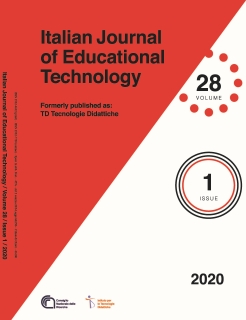Gran Sasso videogame: la fisica e il gioco nei laboratori sotterranei del Gran Sasso
Contenuto principale articolo
Abstract
Gran Sasso videogame è un videogioco ambientato nei Laboratori Nazionali del Gran Sasso, i laboratori sotterranei più grandi al mondo. Protagonista è l’alieno Zot che, catapultato per sbaglio nei Laboratori, riuscirà a tornare a casa solo dopo aver aiutato gli scienziati che vi lavorano a ripristinare quattro esperimenti. Il gioco è accompagnato da materiali didattici e schede di approfondimento che raccontano l’attualità della fisica: la fisica del neutrino, la materia oscura e l’astrofisica nucleare. Una versione preliminare del videogioco è stata utilizzata da ragazzi e presentata a docenti, al fine di ottenere indicazioni per il suo miglioramento. Attualmente, una nuova versione è in corso di realizzazione in vista di una ulteriore sperimentazione più estesa.
Dettagli articolo

Questo lavoro è fornito con la licenza Creative Commons Attribuzione - Non commerciale 4.0 Internazionale.
Gli autori che pubblicano su questa rivista accettano le seguenti condizioni:
- Gli autori mantengono i diritti sulla loro opera e cedono alla rivista il diritto di prima pubblicazione dell'opera, contemporaneamente licenziata sotto una Licenza Creative Common Attribuzione _Non commerciale 4.0 Internazionale.
- Gli autori possono aderire ad altri accordi di licenza non esclusiva per la distribuzione della versione dell'opera pubblicata (es. depositarla in un archivio istituzionale o pubblicarla in una monografia), a patto di indicare che la prima pubblicazione è avvenuta su questa rivista.
- Gli autori possono diffondere la loro opera online (es. in repository istituzionali o nel loro sito web) prima e durante il processo di submission, poiché può portare a scambi produttivi e aumentare le citazioni dell'opera pubblicata (Vedi The effect of Open Access).
Riferimenti bibliografici
Anolli, L., & Mantovani, F. (2011). Come funziona la nostra mente. Apprendimento, simulazione e serious games. Bologna, IT: Il Mulino.
Antinucci, F. (2001). La scuola si è rotta. Perché cambiano i modi di apprendere. Roma-Bari, IT: Editori Laterza.
Associazione Editori Sviluppatori Videogiochi Italiani. (2016). I videogiochi in Italia nel 2015. Dati sul mercato e sui consumatori. Retrieved from http://www.aesvi.it/cms/view.php?dir_pk=902&cms_pk=2617
Associazione Editori Sviluppatori Videogiochi Italiani. (2017). I videogiochi in Italia nel 2016. Dati sul mercato e sui consumatori. Retrieved from http://www.aesvi.it/cms/download.php?attach_pk=1471&dir_pk=902&cms_pk=2773
Associazione Editori Sviluppatori Videogiochi Italiani. (2018). I videogiochi in Italia nel 2017. Dati sul mercato e sui consumatori. Retrieved from http://www.aesvi.it/cms/view.php?cms_pk=2898&dir_pk=902
Bavelier, D., Green, C. S., Han, D. H., Renshaw, P. F., Merzenich, M. M., & Gentile, D. A. (2011). Brains on video games. Nature Reviews Neuroscience, 12(12), 763–768. doi:10.1038/nrn3135
Benassi, A. (2013). Videogiochi e apprendimento collaterale. TD Tecnologie Didattiche, 21(3), 141-144. doi: 10.17471/2499-4324/86
Benassi, A., Orlandi, C., Cantamesse, M., Galimberti, C., & Giacoma, G. (2011). World of Warcraft in the classroom. A research study on social interaction empowerment in secondary school. In D. Gouscos & M. Meimaris (Eds.), Proceedings of the 5th European Conference on Games Based (pp.35-45). Reading, MA, USA: Academic Publishing Limited.
Ceccherelli, A. (2012). Videogiochi e apprendimento tra medium e messaggio. Considerazioni sull'uso didattico dei videogiochi. Rivista Scuola IaD, 6, 92–112. Retrieved from http://rivista.scuolaiad.it/archivio/n06-2012
Clark, D. B., Tanner-smith, E. E., & Killingsworth, S. (2016). Digital games, design, and learning: A systematic review and meta-analysis. Review of Educational Research, 86(1), 1–17. doi: 10.3102/0034654315582065
Connolly, T.M., Boyle, E.A., MacArthur, E., Hainey T., & Boyle, J.M. (2012). A systematic literature review of empirical evidence on computer games and serious games, Computers & Education, 59, 661–686. doi: 10.1016/j.compedu.2012.03.004
Costantini, H., Formicola, A., Imbriani, G., Junker, M., Rolfs, C., & Strieder, F. (2009). LUNA: a laboratory for underground nuclear astrophysics. Reports on Progress in Physics, 72(8). doi: 10.1088/0034-4885/72/8/086301
D’Aprile, G., & Ulloa Severino, A. (2016). I serious game per sostenere l’empowerment di giovani diabetici: il caso “Tako Dojo”. TD Tecnologie Didattiche, 24(1), 29-37. doi: 10.17471/2499-4324/874
Didoni R. (1995). La conoscenza spontanea nei videogiochi. TD Tecnologie Didattiche, 3(2), 16-20. doi: 10.17471/2499-4324/724
Durkin, K. (June 1, 2010). Video games and young people with developmental disorders. Review of General Psychology, 14, 122-140. doi: 10.1037/a0019438
Felicia, P. (2009). Digital games in schools. Retrieved from https://www.isfe.eu/sites/isfe.eu/files/gis_handbook_english.pdf
Gee, J. P. (2005). Good video games and good learning. Phi Kappa Phi Forum, 85(2),33-37. Retrieved from https://gamesandimpact.org/wp-content/uploads/2012/02/GoodVideoGamesLearning.pdf
Girard, C., Ecalle, J., & Magnan, A. (2013). Serious games as new educational tools: how effective are they? A meta-analysis of recent studies. Journal of Computer Assisted Learning, 29, 207–219. doi: 10.1111/j.1365-2729.2012.00489.x
Interactive Software Federation of Europe (2008). Video gamers in Europe. Retrieved from https://www.isfe.eu/content/video-gamers-europe-2008-nielsen-study
Kebritchi, M., Hirumi, A., & Bai, H., (2010). The Effects of Modern Math Computer Games on mathematics achievement and class motivation. Computers&Education, 55(2), 427-443. doi: 10.1016/j.compedu.2010.02.007
Kortemeyer G., Tan, P., & Schirra S. (2013). A Slower speed of light: Developing intuition about special relativity with games. In Proceedings of the 8th International Conference on the Foundations of Digital Games, FDG ‘13 (pp. 400-402). New York, NY, USA: ACM. Retrieved from http://www.fdg2013.org/program/festival/openrelativity.pdf
López, X. (2010). Videogiochiamo dunque impariamo? Un modello per l’analisi educativa dei videogiochi. Roma, IT: Nuova Cultura.
Mayo, M.J. (2009). Video games: A route to large-scale STEM education? Science, 323(5910), 79-82. doi: 10.1126/science.1166900
McClean, P., Saini-Eidukat, B., Schwert, D., Slator, B.M., & White, A. (2001). Virtual worlds in large enrollment science classes significantly improve authentic learning. In J. A. Chambers (Ed.), Selected Papers from the 12th International Conference on College Teaching and Learning (pp. 111–118). Jacksonville, FL, USA: Center for the Advancement of Teaching and Learning.
Pedersen, M. K., Borre, C. C., Lieberoth, A., & Sherson, J. (2016). Knowledge formation and inter-game transfer with classical and quantum physics. In T. Connolly et al. (Eds.), Proceedings 10th European Conference on Games Based Learning (ECGBL 2016) (pp. 1010-1013). Sonning Common, UK: Academic Conferences Limited.
Persico, D., Passarelli, M., Pozzi, F., Earp, J., Dagnino, F.M., & Manganello, F. (2019). Meeting players where they are: Digital games and learning ecologies. British Journal of Educational Technology, 50(4), 1687-1704. doi: 10.1111/bjet.12777
Pirro, S., & Mauskopf, P. (2017). Advances in bolometer technology for fundamental physics. Annual Review of Nuclear and Particle Science, 67, pp. 161-181. doi: 10.1146/annurev-nucl-101916-123130
Ratan, R. A., & Ritterfeld, U. (2009). Serious games. Mechanisms and effects. New York, NY, USA: Routledge. doi: 10.4324/9780203891650
Sherin, Z.W, Cheu, R., & Tan, P. (2016). Visualizing relativity: the OpenRelativity project. American Journal of Physics, 84(5), 369. doi:10.1119/1.4938057
Tanoni, I. (2003). Videogiocando s'impara. Dal divertimento puro all'insegnamento-apprendimento. Trento, IT: Centro Studi Erickson.
Wastiau, P., Kearney, C., & Van den Berghe, W. (2009). How are digital games used in schools?Complete results of the study [Final Report] . Brussels, BE: European Schoolnet. Retrieved from http: Patrick Felicia //games.eun.org/upload/gis-full_report_en.pdf
Wernbacher, T., Pfeiffer, A., Wagner M.G. & Hofstätter, J. (2012). Learning by playing: can serious games be fun? In P. Felicia (Ed.), Proceedings of the 6th European Conference on Games Based Learning (ECGBL 2012), Cork, Ireland, October 4-5, 2012, (pp. 533-541). Sonning Common, UK: Academic Publishing International.
Wouters, P., & van Oostendorp, H. (2013). A meta-analytic review of the role of instructional support in game-based learning. Computers & Education, 60(1), 412–425. doe: 10.1016/j.compedu.2012.07.018

